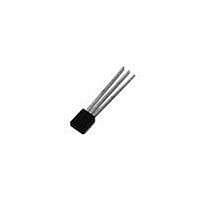SDP8475-201 Honeywell, SDP8475-201 Datasheet - Page 4

SDP8475-201
Manufacturer Part Number
SDP8475-201
Description
Optical Sensors - Board Mount Low Light Rejection Phototransistor
Manufacturer
Honeywell
Datasheet
1.SDP8475-201.pdf
(5 pages)
Specifications of SDP8475-201
Maximum Power Dissipation
70 mW
Package / Case
T-1
Maximum Operating Temperature
+ 85 C
Minimum Operating Temperature
- 40 C
Phototransistor Type
Phototransistor
Polarity
NPN
Number Of Elements
1
Lens Type
Clear
Collector-emitter Voltage
30V
Collector-emitter Sat Volt (max)
0.4V
Dark Current (max)
100nA
Rise Time
15000ns
Fall Time
15000ns
Power Dissipation
70mW
Peak Wavelength
935nm
Half-intensity Angle
20deg
Operating Temp Range
-40C to 85C
Operating Temperature Classification
Industrial
Mounting
Through Hole
Pin Count
2
Package Type
T-1
Lead Free Status / RoHS Status
Lead free / RoHS Compliant
Honeywell reserves the right to make
changes in order to improve design and
supply the best products possible.
SDP8475-201
Low Light Rejection Phototransistor
Designing with the Low Light Rejection
Phototransistor:
The Low Light Rejection detector is tested at different
incident light levels to determine adherence to the
specified knee point and light current slope. This method
assures proper functionality vs. standard
phototransistors, and guarantees required light current
output.
The light current slope is the change in light current
output at two given source irradiances divided by the
change in the two source irradiances.
(Formula # 1)
I
Where:
Chart A shows the specified limits of light current slope
for the low light rejection phototransistor which begins its
slope at the typical knee point, 0.125mW/cm
clear distinction between this device and a standard
phototransistor, light current slopes for high and low
sensitivity standard phototransistors are also shown.
Note that for phototransistors of the same gain, the
slopes of the two products are parallel.
L
Slope = [I
I
I
H is the source intensity in mW/cm
L
L
is the light current output in mA
7.00
6.00
5.00
4.00
3.00
2.00
1.00
0.00
slope is the light current slope in mA/mW/cm
0.000
L 1
(@ H
Chart A. Low Light Rejection Phototransistor vs. Standard Phototransistor
1
) - I
L2
(@ H
0.125
2
)] / [H
1
2
- H
Source intensity - mW/cm
2
]
2
. To make a
0.250
2
2
The knee point, the source irradiance needed to increase
I
All variation in the knee point will be offset by the
internally guardbanded light current slope limits. The
appropriate formula for circuit design is the following:
(Formula # 2)
I
Where:
Example :
To design a transmissive sensor with two of Honeywell’s
standard components, the SEP8505-002 and the
SDP8475-201, it is first necessary to determine the
irradiance level in mW/cm
detector. The application conditions are the following:
L
L
to 50uA, is a necessary parameter for circuit design.
= I
0.375
L
I
I
slope (i.e. 4.0mA/mW/cm
H
application
H
the detector at the typical knee point (i.e. 0.125
mW/cm
L
L
slope
A
KP
is the light current output in mA
slope
is the source light incident on the detector for the
is the specified level of source light incident on
MIN.
MIN.
2
)
* (H
is the minimum limit on the light current
A
- H
KP
0.500
)
2
that will be incident on the
2
)
Min. Light
Current Slope
Max. Light
Current Slope
Min. Light
Current Slope
Standard
Max. Light
Current Slope
Standard
139











